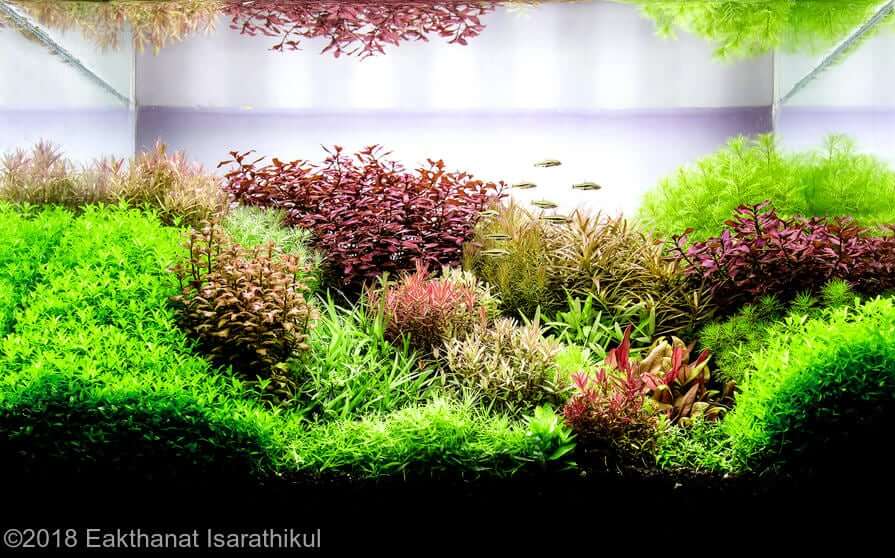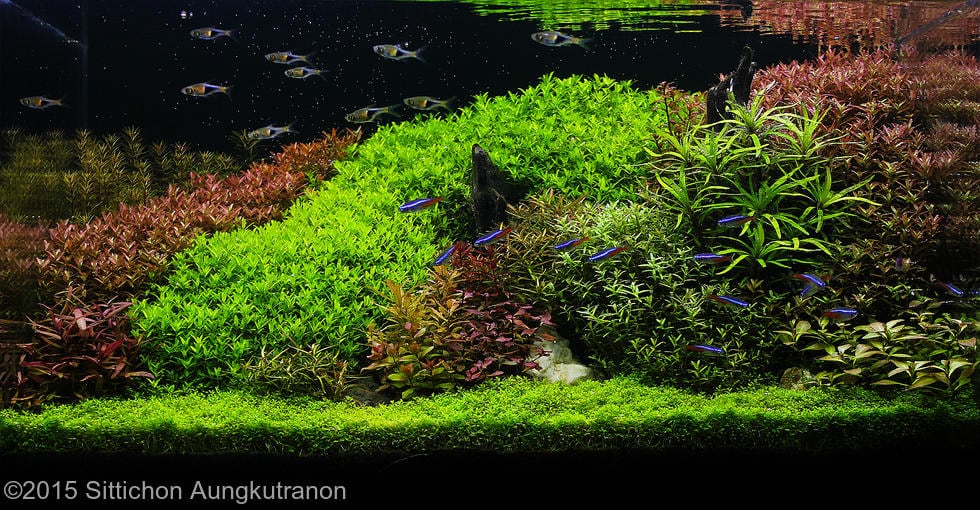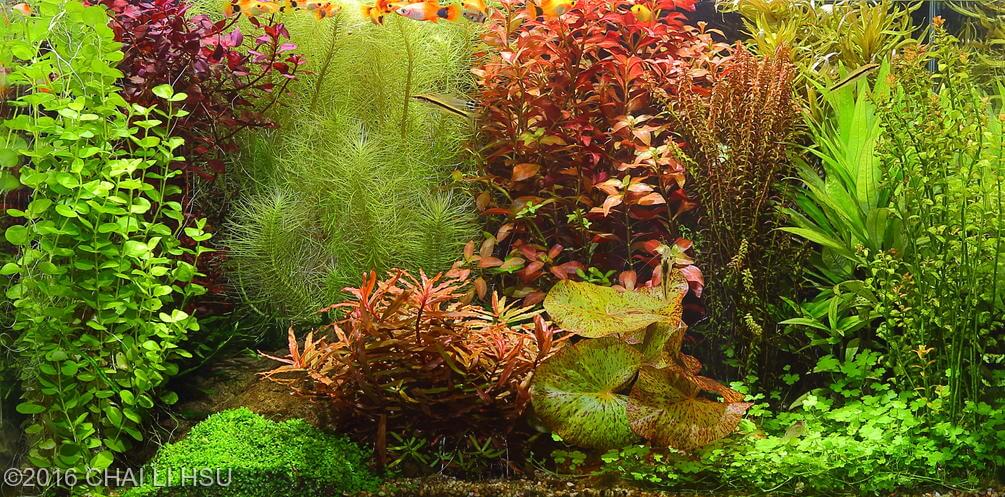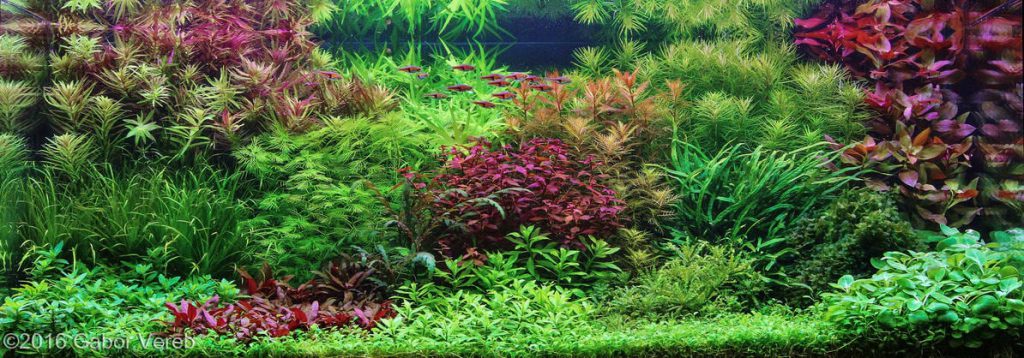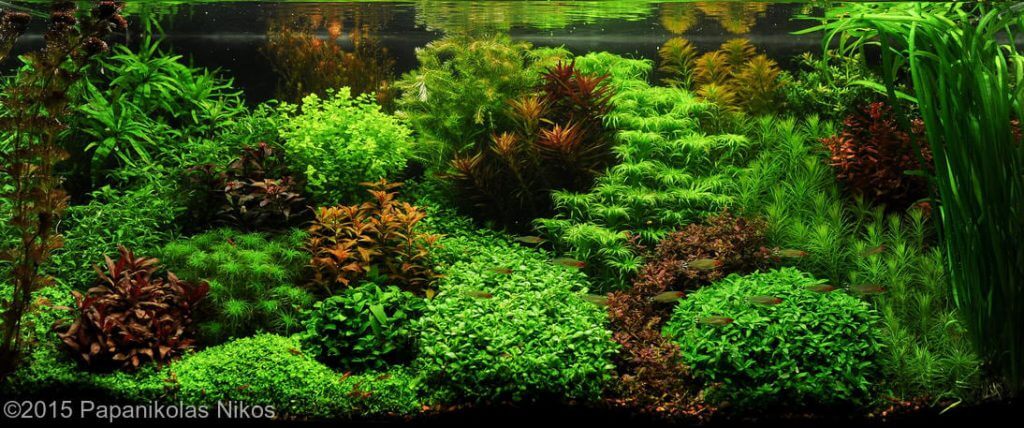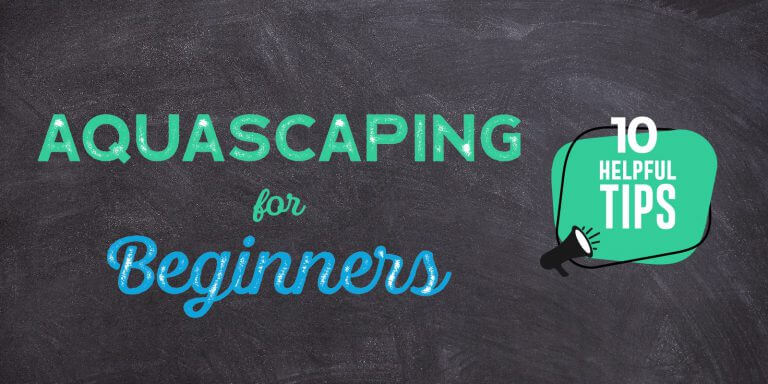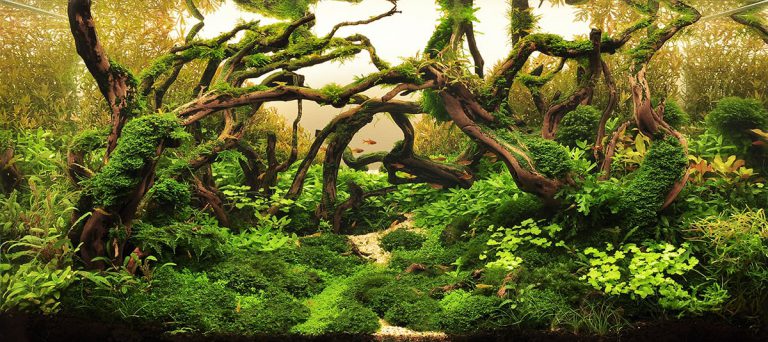Two major aquascaping styles dominate the world of freshwater aquariums: the Nature and the Dutch style. Out of these two, the Dutch Aquarium Aquascape is the oldest, becoming popular during the 1930’s in the Netherlands, with the implementation of the NBAT – the Dutch Society for Aquarists.
Special Features of the Dutch Aquarium
The Dutch Aquarium style does not imply the use of wood, rocks and other hardscape materials. The main focus is placed upon the growth and arrangement of aquatic plants.
Traditionally, Dutch planted aquariums are compared to underwater gardens. However, differentiating from the Nature style, Dutch aquascapes are not meant to resemble a specific biotope.
The intricate placement and grouping of plants help create in-depth perspective within the aquarium by complimenting each other in shape and color.
The most important requirement for aquascapers who want to approach the Dutch Aquarium style is to have extensive knowledge regarding aquatic plants. Since they represent the main materials used in Dutch aquascaping, it is very important to know how to plant, group and combine them so that the final arrangement would become aesthetically pleasing to the eye.
Most magnificent Dutch planted aquariums are characterized by high density, rich contrast and subtle use of color and texture.
Design and Layout Techniques Applied to the Dutch Aquarium Style
The most common technique used when building a Dutch Aquarium style is terracing, because it is the most optimal when it comes to conveying depth using plants.
Terracing is very efficient in creating and emphasizing the focal points with the help of the rule of thirds. With the Dutch aquascape, the focal point is usually emphasized by the use of a red or large plant.
Keeping a sense of harmony and simplicity is crucial, taking into account that Dutch planted aquariums are very dense. More than 70% of the aquarium floor should be planted.
Contrast is a key element in the Dutch Aquarium style, as it is important when it comes to breaking this density. Plants are grown in groups and contrast is ensured by diligent use of color variation, leaf height and texture.
Spaces between plant groups should be used wisely as well, as this creates imaginary streets and pathways, helping out with the in-depth perspective.
Common Used Plants in the Dutch Aquarium
Stem plants are often recommended for the Dutch style setup because they have fast growing rates, a wide range of leaf color and shape. 3 plant species per foot should be enough to ensure good color contrast. Also, due to the fact that aquarium equipment should remain hidden in the back of the tank, cork backing and moss walls are a good option in that area.
Here are some species of plants most commonly used in Dutch style planted aquariums:
- Saurus cernuus and Lobelia cardinalis – low growing plants which help create the so called ‘dutch street’, a pathway set at the viewing angle, which ascends toward the back of the tank, creating the illusion of depth.
- Hygrofilia corymbosa and Limnophila aquatica – large stem plants which grow fast and have a strong visual effect.
- Plants of the Cryptocoryne species (lucens, lutea, walkeri, wendtii and becketii) – small aquatic plants used in the first two rows of the aquarium, they provide good contrast due to their dark earthy colors.
- Plants used in Dutch scapes focal points for color highlights (Alternanthera reineckii, Ammania, Rotala) and size (solitary plants like Tiger Lotus or Aponogetons).
- Java moss – often used between plant groups, with the purpose of creating contrast, or on pieces of hardscape, in order to create a focal point.
Recommended Fish for the Dutch Aquascaping Style
The role of fish in the Dutch Aquarium is more of an additional one, but nevertheless, quite important. The three areas of the tank should be filled with fish that emphasize the beauty of each of them.
Schools are preferred, and as large as possible, however larger fish like Congo tetras or Angelfish are always a good choice.
Equipment
The same equipment is used in a Dutch style planted aquarium as in a traditional aquarium:
- Lighting – standard fluorescent lamps are normally used
- Filtration systems – canister filters or sumps
- CO² addition – injected in a range of 15 to 20ppm
- Substrate system – clay or laterite, small sized gravel
- Fertilizers – doses of iron and minerals on a regular basis
Maintenance Difficulties in the Dutch Aquarium
The Dutch aquascape is anything but a chaos. At most, it is a controlled chaos. Each plant has its own characteristics and behaves in its own way. As opposed to the Nature style aquascapes, Dutch style planted aquariums require frequent plant trimming, which can become tedious, but if done correctly and skillfully, it can definitely ensure a clean, organized, aesthetically pleasing foreground-background design.
On the downside, Dutch style aquascapes usually look better when viewed from a certain angle, ideally the front, but this is by no means discouraging.
Daily Dutch aquascape maintenance includes: adding liquid fertilizer, checking tank temperature and CO² level, feeding fish and removing floating leaves and other debris.
On weekly basis, the following actions are recommended: cleaning the aquarium glass, dislodging accumulated debris by hand waving around plants and substrate, cleaning the filters, pruning and replanting (if necessary).
Key aspects in the Dutch Aquarium Judging Contest Scoring
- the health of aquatic plants, fish and other species
- water parameters (optimal temperature, suitable levels of phosphate and nitrates; hardness)
- selection of plants, use of color and contrast
- selection and compatibility and number of fish in comparison to the size of the aquarium and environmental conditions
- general design and layout
- equipment setup (should be out of view)
Enjoyed this article? Spread the word by sharing it with your friends!



